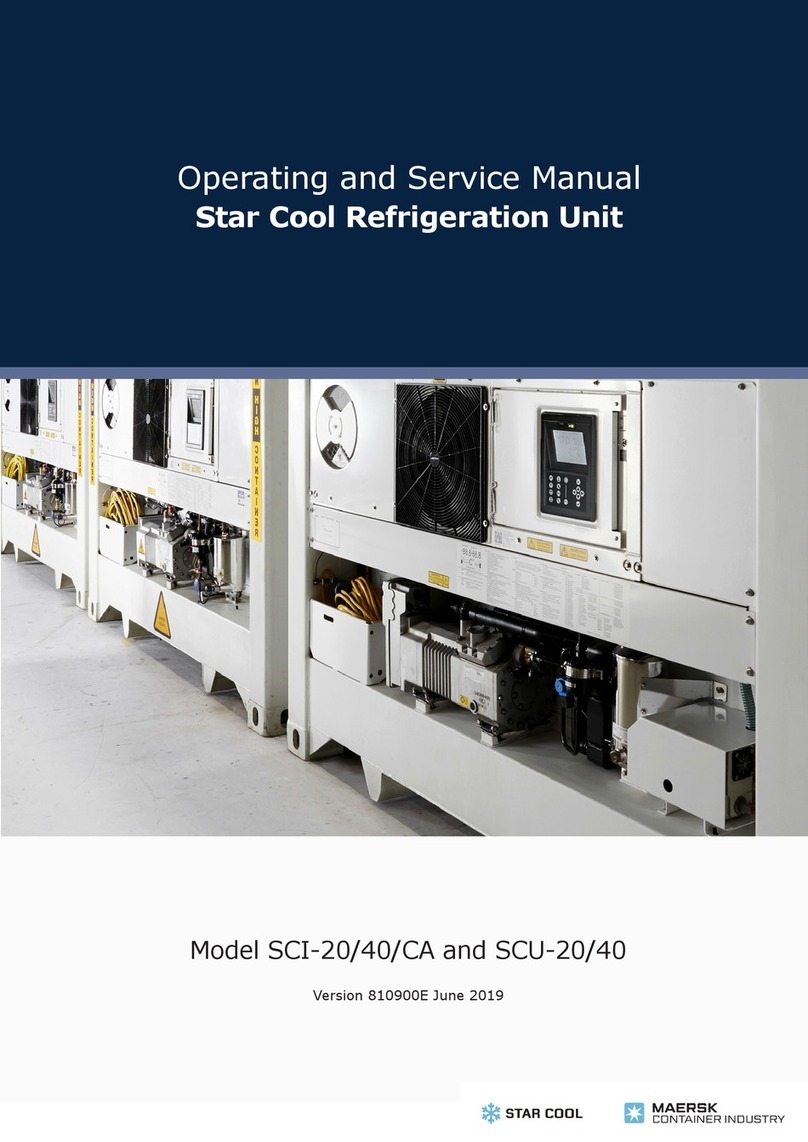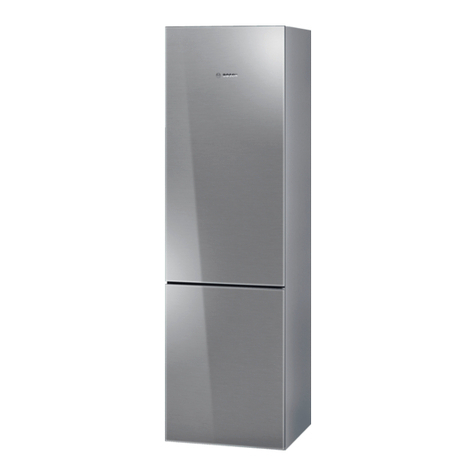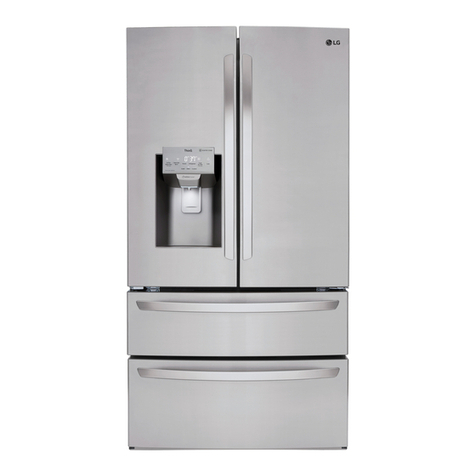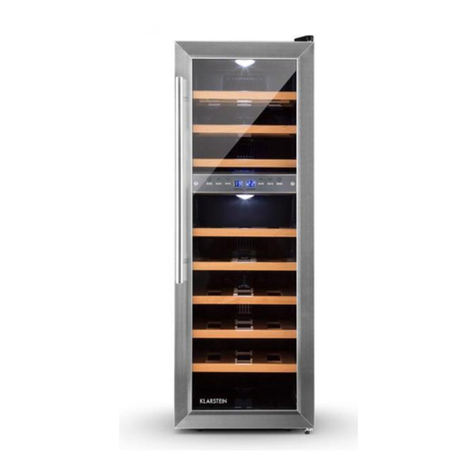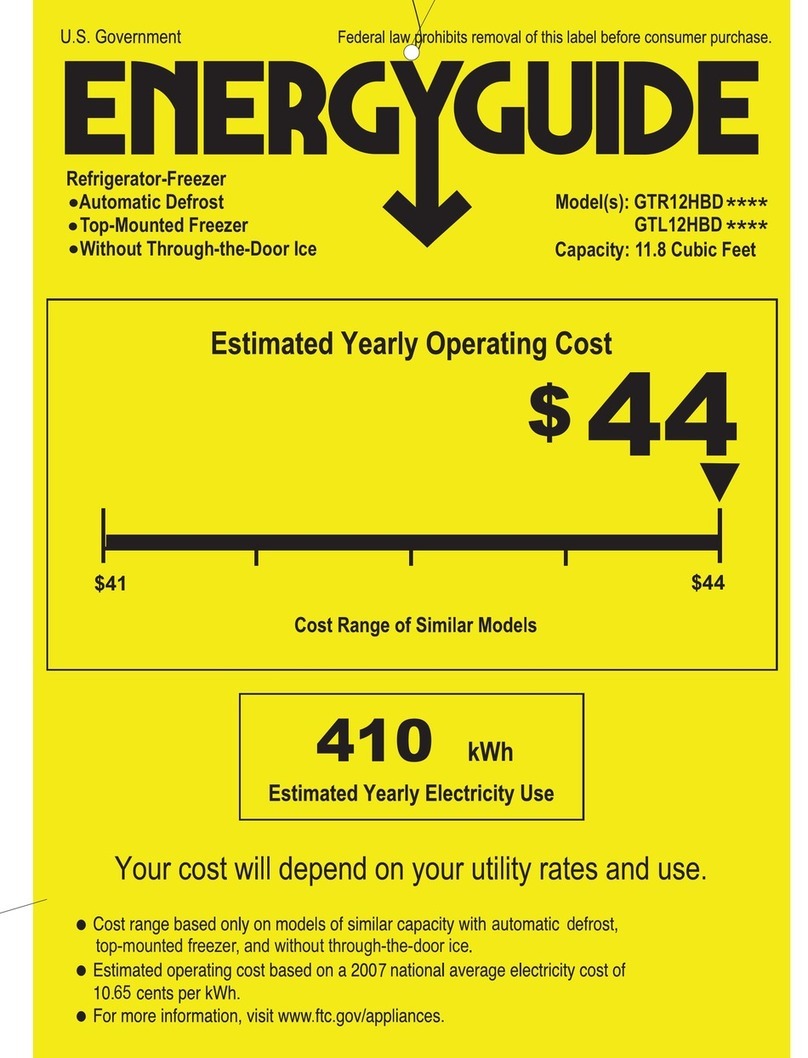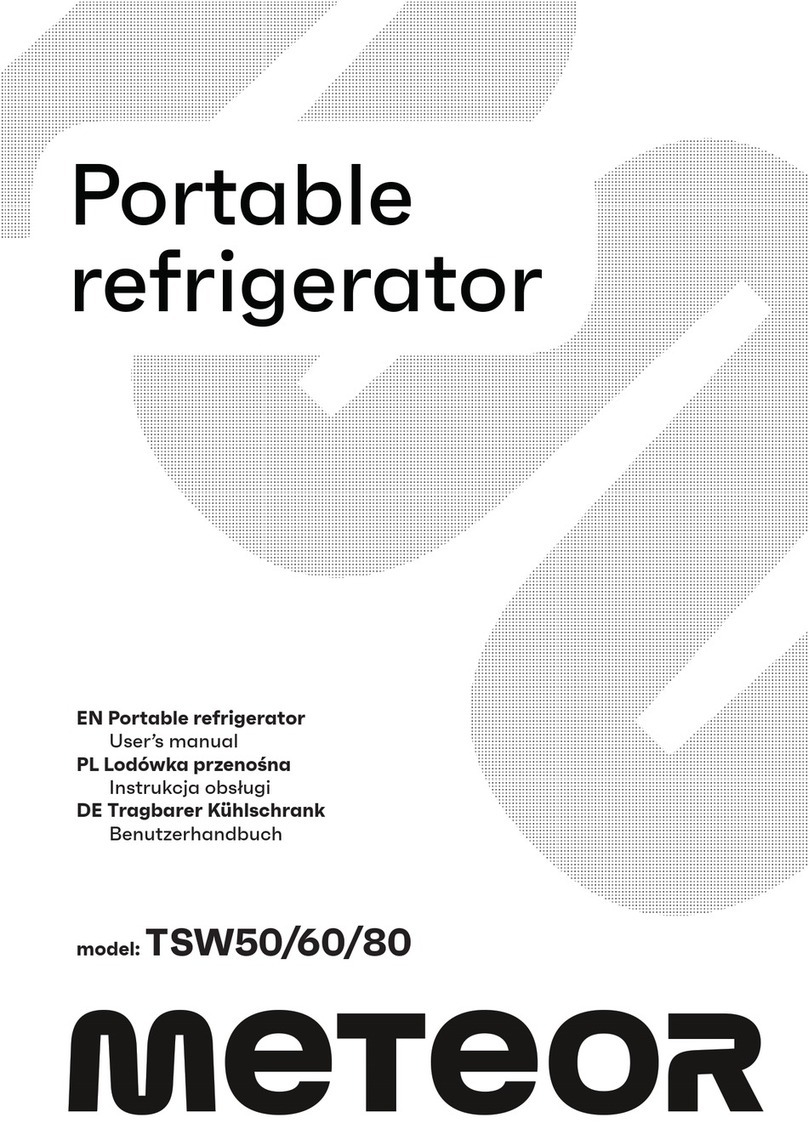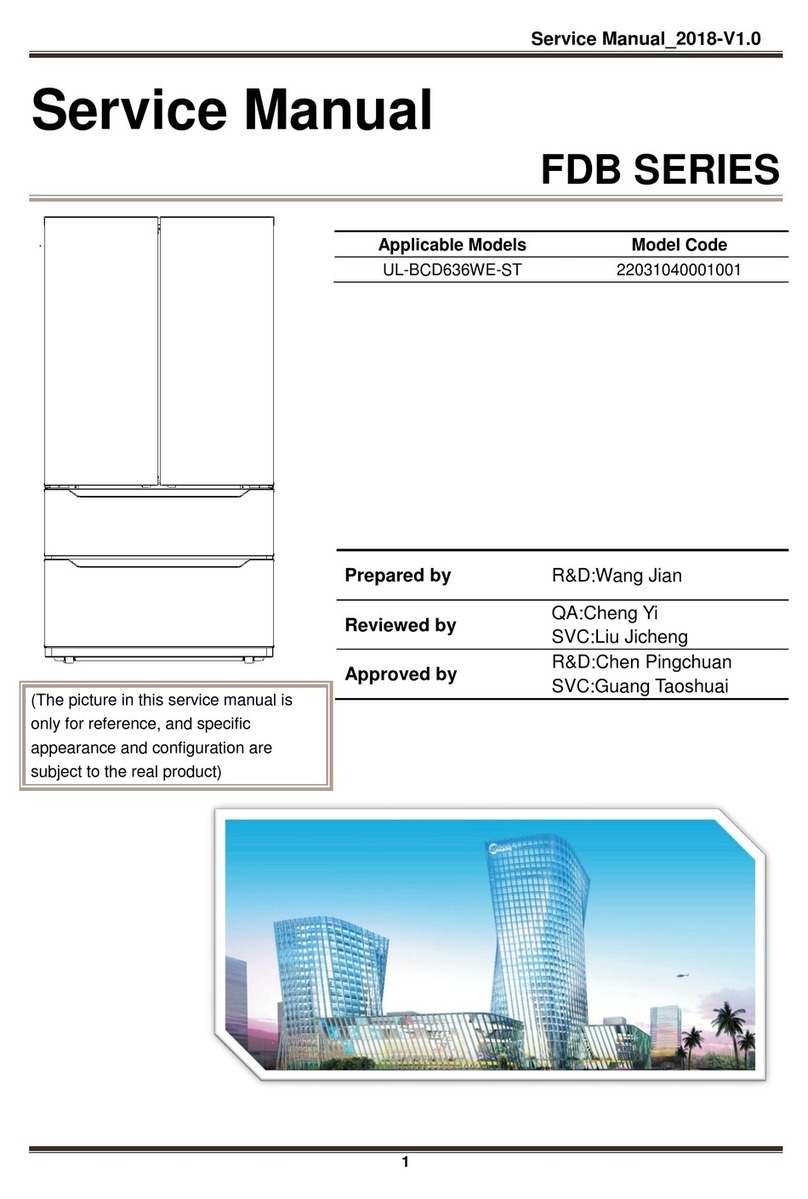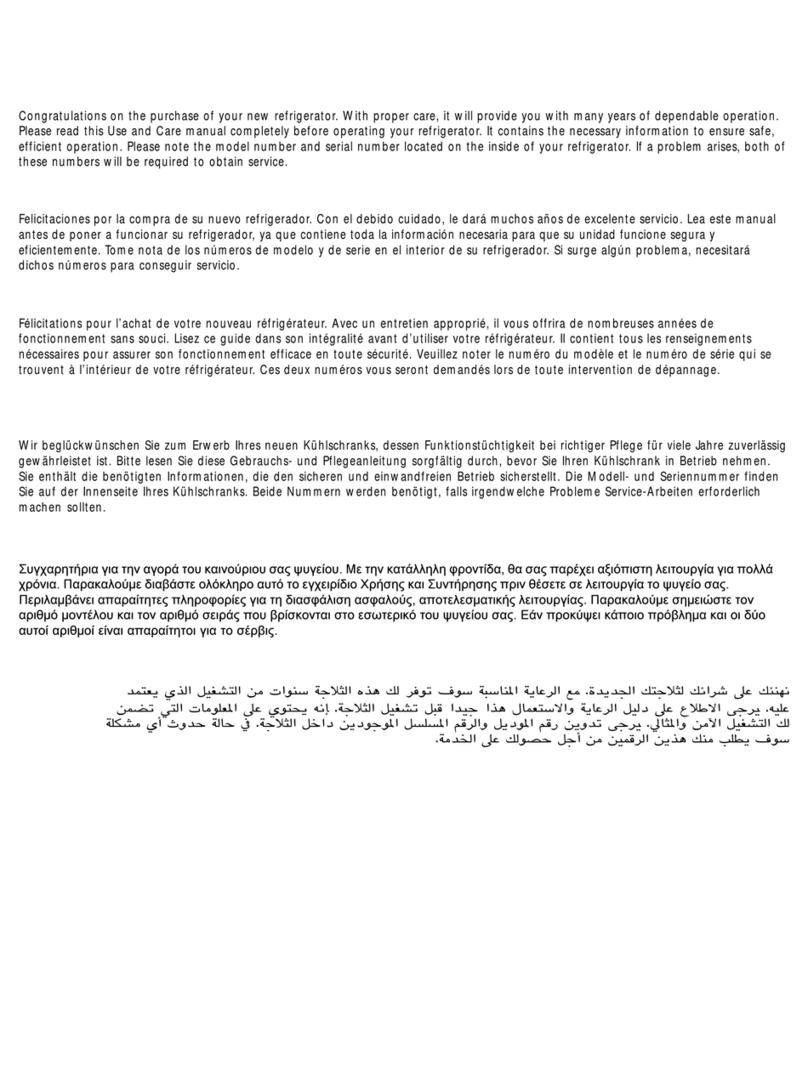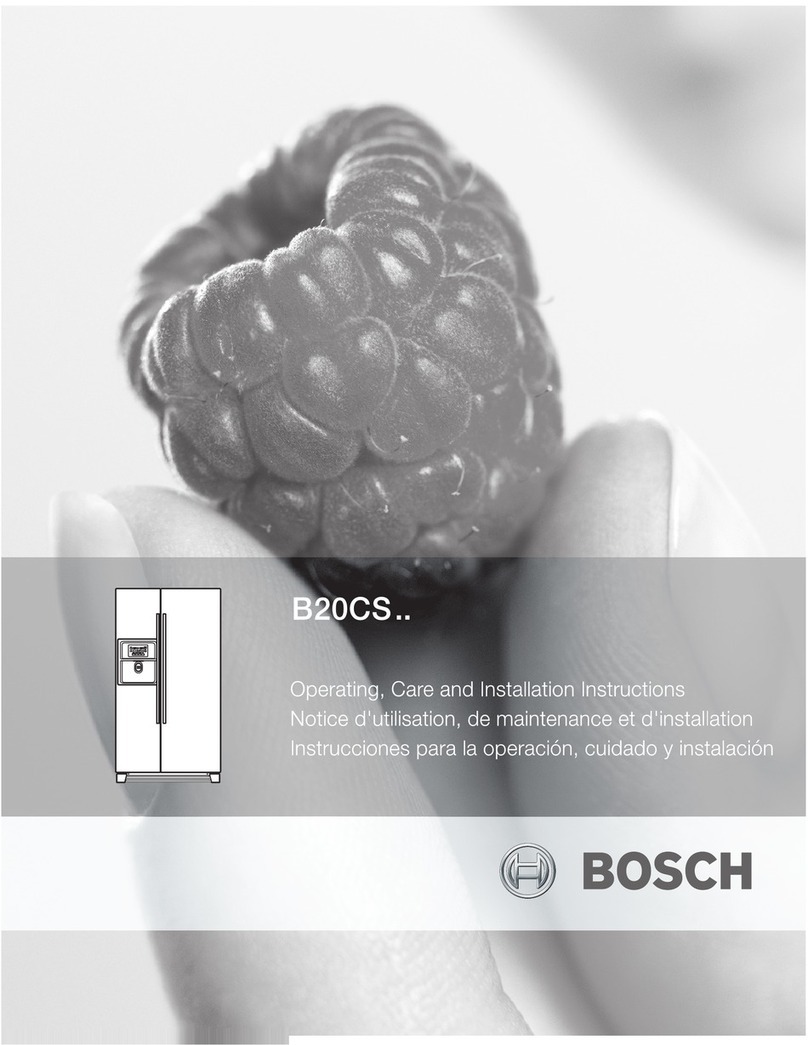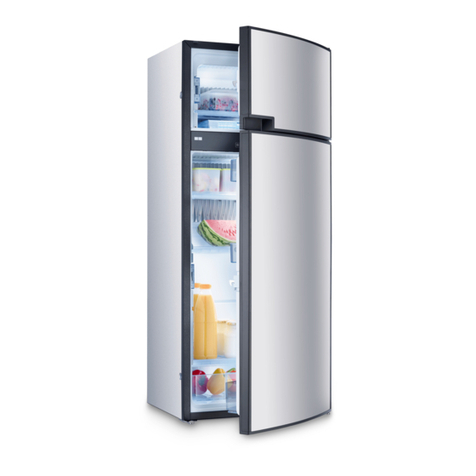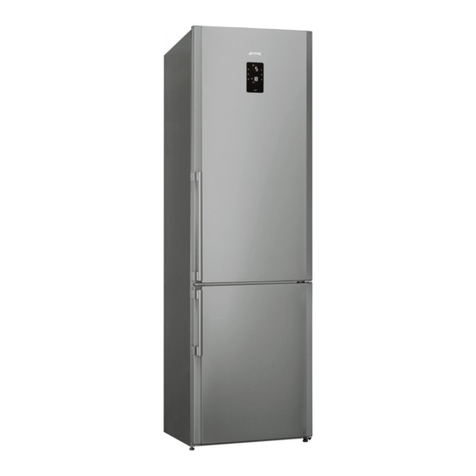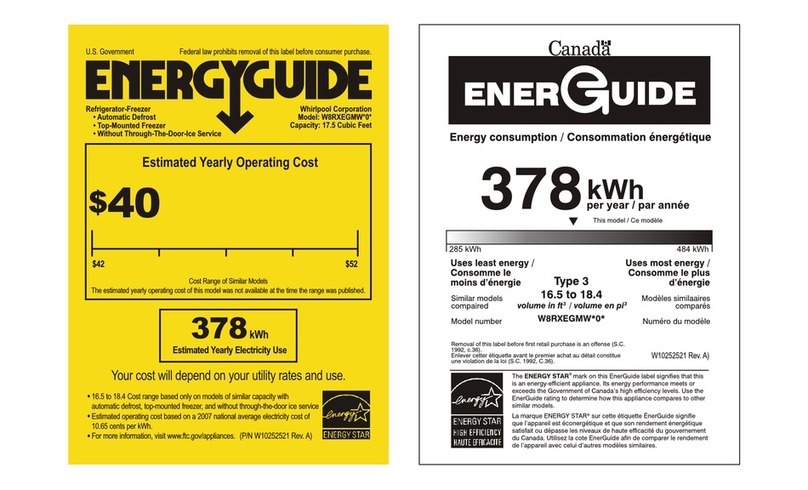Maersk Container Industry Star Cool SCI-20 Service manual

Operating and Service Manual
Star Cool Refrigeration Unit
Version 810900E May 2021
Model SCI-20/40/CA and SCU-20/40

1 of 116 pages
1. Preface
This version of the manual is dated May 2021, edited by Maersk Container Industry AS.
All rights reserved.
This user’s manual is valid for software version 0357 or newer versions.
The information herein is subject to change without notice and does not represent a commitment
on any part of Maersk Container Industry AS. While the information herein is assumed to be accu-
rate, Maersk Container Industry AS assumes no responsibility for any errors or omissions that may
appear in this documentation.
This manual is valid for:
Model SCI - 20/40/CA and SCU - 20/40
Software version 0357
2. Warnings
Do not operate or maintain this refrigeration unit until you have familiarized yourself completely with
the equipment and operation of this unit by reading the instructions in this manual.
Do not perform any welding on the unit before disconnecting the power plug. Furthermore, discon-
nect the power measurement module and main controller (and modem if present).
Disconnect the main power supply to the unit before inspecting the interior of the controller box.
The unit is charged with R134a or R513A and ester oil BSE 55. Do not use any other refrigerant or
oil. Do not use contaminated refrigerant or oil. Never release any refrigerant into the atmosphere.
Use recovery equipment according to present legislation.
During maintenance, please observe that refrigerants operate with high and low temperatures in
combination with high pressures, which may cause personal injuries if not handled properly.
During recovery and maintenance of the refrigerant, personal protection equipment must be worn.
Do not trap any liquid refrigerant inside pipes during soldering work. This may lead to an explosion
of the pipes.
Please note that some unit models do not have Schräder valves installed for Psuc and Pdis transmit-
ters.
We do not recommend cleaning the inside of a reefer container with soap/chemicals with a PH value
below 7. However, if this occurs, clean the evaporator coil through the inspection hatches with a soap
that has a PH value between 7 and 9. This cleaning is vital to reduce the risk of copper damage in
the evaporator coil.
Do not enter the container, including opening the service hatches, when the oxygen level is below
20.9%. Ventilation is necessary before entering, either for repairing the unit or unloading. Stay away
from doors while venting.
Human response to low oxygen atmosphere:
Oxygen content of air Symptoms of a person exposed
20.9% Level in ambient air - no eect.
15% - 19% May impair coordination and induce early symptoms in persons
who have coronary, pulmonary, or circulatory problems.
12% - 15% Respiration and pulse increase, impaired coordination, poor per-
ception and judgement.
10% - 12% Respiration increases further in rate and depth, poor judgement,
and bluish lips.
8% - 10% Mental failure, fainting, unconsciousness, an ash-coloured face,
blue lips, nausea, and vomiting.
6% - 8% 8 minutes - 100% fatal, 4-5 minutes - recovery with treatment.
4% - 6% Coma within 40 seconds, convulsions, respiration ceases, death.

2 of 116 pages
3. Contents
1. Preface......................................................................................................................................................... 1
2. Warnings...................................................................................................................................................... 1
3. Contents....................................................................................................................................................... 2
4. Legend ......................................................................................................................................................... 6
5. General description...................................................................................................................................... 8
6. Function description .................................................................................................................................... 9
6.1 Start-up procedure ................................................................................................................................ 9
6.2 Temperature control............................................................................................................................... 9
6.3 Capacity control and limiter ...................................................................................................................10
6.4 Electrical control...................................................................................................................................12
6.5 Expansion valve....................................................................................................................................12
6.6 Economizer valve..................................................................................................................................12
6.7 Dehumidication...................................................................................................................................13
6.8 Condenser fan......................................................................................................................................13
6.9 Evaporator fan......................................................................................................................................14
6.10 Defrost function ..................................................................................................................................14
6.11 Alarm Action System ...........................................................................................................................15
6.12 Datalog..............................................................................................................................................15
7. Te s t s ............................................................................................................................................................17
7.1 Function test ........................................................................................................................................18
7.2 Full PTI ................................................................................................................................................19
7.3 Short PTI .............................................................................................................................................19
7.4 CA PTI .................................................................................................................................................19
8. Refrigeration system data...........................................................................................................................19
8.1 Refrigerant charge ...............................................................................................................................19
8.2 General specication.............................................................................................................................19
8.3 Compressor – motor assembly ...............................................................................................................20
8.4 Frequency converter .............................................................................................................................20
8.5 Evaporator coil .....................................................................................................................................20
8.6 Evaporator coil heaters..........................................................................................................................20
8.7 Evaporator fan......................................................................................................................................20
8.8 Evaporator fan motor ............................................................................................................................21
8.9 Condenser coil......................................................................................................................................21
8.10 Condenser fan ....................................................................................................................................21
8.11 Condenser fan motor ...........................................................................................................................22
8.12 Water cooled condenser (optional) ........................................................................................................22
8.13 Fresh air exchange ..............................................................................................................................22
8.14 Air exchange motor .............................................................................................................................22
8.15 Economizer ........................................................................................................................................23
8.16 Refrigeration controls ..........................................................................................................................23
8.17 Vacuum pump.....................................................................................................................................23
8.18 Electrical data.....................................................................................................................................23
8.19 Circuit breaker....................................................................................................................................23
8.20 Contactors .........................................................................................................................................23
8.21 High pressure cut out switch ................................................................................................................23
8.22 Fusible plug, receiver ..........................................................................................................................24
8.23 Fuses.................................................................................................................................................24
8.24 Power plug .........................................................................................................................................24
8.25 Power cable........................................................................................................................................24

3 of 116 pages
8.26 USDA socket requirements...................................................................................................................24
8.27 O2sensor...........................................................................................................................................24
8.28 CO2sensor.........................................................................................................................................24
8.29 Temperature sensors, including USDA ...................................................................................................25
8.30 Relative humidity sensor......................................................................................................................25
8.31 CA pressure transmitter.......................................................................................................................25
8.32 Pressure transmitters ..........................................................................................................................25
8.33 Miscellaneous .....................................................................................................................................25
9. User interface .............................................................................................................................................26
9.1 Indicator lights .....................................................................................................................................26
9.2 Display ................................................................................................................................................26
9.3 Keypad ................................................................................................................................................27
10. Menu overview ..........................................................................................................................................28
10.1 General page layout ............................................................................................................................28
10.2 Using the cursor..................................................................................................................................29
10.3 Changing a parameter value.................................................................................................................29
10.4 Activating a function............................................................................................................................29
10.5 Air exchange page...............................................................................................................................29
11. Operation ..................................................................................................................................................30
11.1 Menu structure ...................................................................................................................................30
11.2 General operation ...............................................................................................................................31
11.3 Temperature setting ............................................................................................................................31
11.4 Wake-up mode ............................................................................................................................31
11.5 Contrast adjustment of the display........................................................................................................31
11.6 °C and °F temperature scale showing ............................................................................................31
11.7 Viewing graph of supply and return temperature .............................................................................32
11.8 Water-cooling activation/deactivation ............................................................................................32
11.9 PTI or function test execution .......................................................................................................32
11.10 Information menu..............................................................................................................................36
11.11 Raw sensors .....................................................................................................................................39
11.12 Operation parameter settings .....................................................................................................41
11.13 Programs..........................................................................................................................................42
11.13.1 Multiple Temperature Setpoints program, MTS ...................................................................................42
11.13.2 Automatic Cold Treatment program, ACT ...........................................................................................43
11.13.3 Bulb mode .....................................................................................................................................44
11.14 Application settings ...........................................................................................................................45
11.14.1 AV/AV+ settings ..............................................................................................................................45
11.14.2 CA settings ....................................................................................................................................46
11.15 Manual defrost ..................................................................................................................................48
11.16 Alarms ............................................................................................................................................48
11.17 Service function settings ............................................................................................................49
11.18 Manual operations ............................................................................................................................ 50
11.18.1 FC self test.....................................................................................................................................51
11.19 Datalog view .................................................................................................................................... 52
11.20 Time adjust ......................................................................................................................................53
11.21 Run time counters .............................................................................................................................53
11.22 Conguration....................................................................................................................................54
11.22.1 StarConomy ..................................................................................................................................56
11.23 Serial numbers..................................................................................................................................56
11.24 USB menu ........................................................................................................................................57
11.25 Maintenance .....................................................................................................................................58
11.26 Modem .............................................................................................................................................58
12. External interfaces....................................................................................................................................58
12.1 General requirements..........................................................................................................................59
12.2 List of terms used for external interfaces...............................................................................................59
12.3 Functions overview..............................................................................................................................59

4 of 116 pages
13. Events .......................................................................................................................................................60
14. Detailed alarm description ....................................................................................................................... 63
14.1 Alarm list ...........................................................................................................................................63
15. Star Cool unit installation dimensions.......................................................................................................68
16. Location of motors, temperature sensors, humidity sensor and air exchange potentiometer ..................69
17. Location of valves......................................................................................................................................70
18. Location of pressure transmitters, high pressure switch and oil outlet port ............................................71
19. Controller unit illustration.........................................................................................................................72
20. Location of AV and CA components ...........................................................................................................73
21. Replacements............................................................................................................................................76
21.1 Replacement of evaporator motor and fan..............................................................................................76
21.2 Replacement of condenser motor and fan ..............................................................................................76
21.3 Replacement of evaporator...................................................................................................................77
21.4 Replacement of heating elements......................................................................................................... 78
21.5 Replacement of FC ..............................................................................................................................79
21.6 Replacement of compressor .................................................................................................................80
21.7 Replacement of compressor valve plate/cylinder head gasket ...................................................................81
21.8 Replacement of lter dryer...................................................................................................................82
22. Service and maintenance ..........................................................................................................................82
22.1 Evacuation of refrigerant .....................................................................................................................82
22.2 Compressor pump down and operation..................................................................................................83
22.3 Compressor pump down (replaced) .......................................................................................................83
22.4 Pump down of unit .......................................................................................................................... ...84
22.5 Pressure test ......................................................................................................................................84
22.6 Charging of refrigerant ........................................................................................................................85
22.6.1 Charging of an empty unit .................................................................................................................85
22.6.2 Charging of unit low on charge...........................................................................................................86
22.7 Leakage detection...............................................................................................................................86
22.8 Compressor........................................................................................................................................86
22.8.1 Check of oil level ..............................................................................................................................86
22.8.2 Draining of oil from compressor .........................................................................................................87
22.8.3 Charging of oil .................................................................................................................................87
22.9 Soldering ....................................................................................................................................... ...88
22.9.1 Welding ...........................................................................................................................................88
22.10 Calibration of air exchange sensor .......................................................................................................88
22.11 Sensor calibration using StarView .......................................................................................................88
23. CA service and troubleshooting ................................................................................................................89
23.1 Container venting procedure.................................................................................................................89
23.2 Vacuum pump service..........................................................................................................................89
23.3 Trouble shooting the vacuum system.....................................................................................................91
23.4 Replacement of the vacuum pump heating element.................................................................................93
23.5 CA preparation....................................................................................................................................93
22.6 Curtain track installation......................................................................................................................94
22.7 Curtain installation..............................................................................................................................95
22.8 Container leak test..............................................................................................................................95
22.9 CA+ ushing.......................................................................................................................................96

5 of 116 pages
24. General trouble shooting ..........................................................................................................................97
25. Emergency operation ................................................................................................................................98
25.1 FC bypass ..........................................................................................................................................98
25.1.1 FC 1.0 and FC 1.1 .............................................................................................................................98
25.1.2 FC 2.0 .............................................................................................................................................98
25.2 Controller bypass................................................................................................................................99
25.2 Evaporator fan motor bypass................................................................................................................99
26. Tables......................................................................................................................................................100
26.1 Datalog description ...........................................................................................................................100
26.2 Temperature sensor - resistance table.................................................................................................102
26.3 Temperature sensor - voltage table.....................................................................................................103
26.4 Air exchange sensor voltage table - m3/h for 35 CMH ............................................................................104
26.5 Air exchange sensor voltage table - m3/h for 75 CMH ............................................................................104
26.6 Voltage – pressure table, LP transmitter (NSK) + DST...........................................................................105
26.7 Voltage – pressure table, LP transmitter (AKS) .....................................................................................106
26.8 Voltage – pressure table, HP transmitter (NSK) + DST ..........................................................................107
26.9 Voltage – pressure table, HP transmitter (AKS) ....................................................................................108
26.10 Pressure - temperature table for R134a ............................................................................................ 109
26.11 Pressure - temperature table for R513A ............................................................................................ 109
26.12 Tightening torques...........................................................................................................................110
27 Diagrams..................................................................................................................................................111
27.1 P & I diagram....................................................................................................................................111
27.2 CA diagram.......................................................................................................................................112
28. Overall wiring schematic - CIM 6.0 with sub-controller ..........................................................................113
29. Overall wiring schematic - CIM 6.1 .........................................................................................................114
30. Overall wiring schematic - CIM 6.2 .........................................................................................................115
31. Overall wiring schematic - CIM 6.2 with sub-controller ..........................................................................116

6 of 116 pages
4. Legend
Short name Name Short name Name
AAS Alarm Action System Mcpr Compressor motor
Act Actual Mevap Evaporator motor
ACT Automatic Cold Treatment Mevap1 Evaporator motor 1
AirEx Air exchange Mevap2 Evaporator motor 2
AKS Danfoss pressure transmitter MOP Maximum operating pressure
AL Alarm Mpump Vacuum pump motor
Atm Atmosphere MTS Multi Temperature Setpoints program
AV Automatic Ventilation NSK/DST Saigonomya/DST P100 pressure
transmitter
CA Controlled Atmosphere
CalUs1 Calibration USDA sensor 1 OH Overheat
CalUs2 Calibration USDA sensor 2 P Pressure
CalUs3 Calibration USDA sensor 3 PCB Printed circuit board
CapReq Requested capacity Pdis Discharge pressure
Com Communication Pmem Pressure membrane
Cond Condenser Psuc Suction pressure
Cpr Compressor PTI Pre Trip Inspection
CT Cold treatment PTI Short Pre Trip Inspection Short
Cur Current Ptot Power total
Err Error PWM Pulse Width Modulation
Evap Evaporator Pwr Power
FFrequency Req Requested
Fact Compressor actual frequency RH Relative humidity
FC Frequency converter RHset Relative humidity setpoint
Fcpr Compressor frequency RMM Remote Monitoring Modem
FcprAct Compressor frequency actual S Switch contact key
FcprReq Compressor frequency requested SC Star Cool
Fpower Power supply frequency converter Set Setpoint
FT Function test SH Superheat
FW Firmware Shp High pressure switch
HHeater Sup Supply
Hevap Evaporator heater TTemperature
HP High pressure Tact Actual temperature
HPS High pressure switch Tamb Ambient temperature
Hpump Vacuum pump motor heating element TC Calculated condenser temperature
I Current Tcargo Cargo temperature
I1 Current phase 1 TCmin Temperature condenser minimum
I2 Current phase 2 Tevap Evaporator temperature
I3 Current phase 3 Tfc Frequency converter temperature
Ifc Current in AC compressor motor Tint Tinternal (controller board)
Init Initialization T0 Calculated suction temperature
ITI Intelligent Trip Inspection Tret Return air temperature
ITOT Total current limit Tset Temperature setpoint
LED Light emitting diode Tsuc Suction temperature
LP Low pressure Tsup Supply air temperature average
MMotor Tsup1 Supply air temperature 1
Mcond Condenser motor Tsup2 Supply air temperature 2

7 of 116 pages
Short name Name
Tusda1 USDA 1 temperature
Tusda2 USDA 2 temperature
Tusda3 USDA 3 temperature
Ubat Battery voltage
Udc DC voltage in frequency converter
U/f Voltage/frequency ratio
VValve
Veco Economizer valve
Vexp Expansion valve
Vhg Hot gas valve

8 of 116 pages
5. General description
The STAR COO
L
units, models SCU-40 and SCI-40 are electric powered picture frames, cooling
and heating units operating on refrigerant R134a or R513A.
The unit is designed to maintain cargo temperatures in a range from -30°C (-22°F) to +30°C (+86°F).
The unit is designed to operate in ambient temperatures from -30°C (-22°F) to +50°C (+122°F).
The outer front frame is constructed of marine grade aluminum, 5000 and 6000 series, designed to
serve adequately as the container end wall. The rear bulkhead is made of food-approved material.
The unit is designed to operate under seagoing and environmental conditions as specied below:
• Salt-laden air, sea spray, and high humidity.
• Rolling: Amplitude of 30° each side, period of 13 seconds.
• Pitching: Amplitude of 6° each side, period of 8 seconds.
• Permanent list: 15° on each side.
• Shock: 2g horizontal and 5g vertical.
• Vibrations: Of the types encountered on ships, trucks, and rail.
The unit consists of the following modules:
• Frame module
• Condenser/compressor module
• Evaporator module
• Evaporator fan module
The cooling system of the unit is equipped with a two–stage compressor, electrically driven through
a frequency converter.
The cooling system is also equipped with an economizer, which performs the task of sub-cooling the
liquid from receiver to evaporator, thereby increasing the cooling capacity of the cooling unit. The
evaporator and economizer are controlled by electronic expansion valves.
The equipment is designed to operate on a 3 phase primary power source at 50 Hz (+/- 2.5) and
360-460 V AC (max. 465 V AC) or at 60 Hz (+/- 2.5) and 400-500 V AC (max. 535 V AC), accord-
ing to ISO 1496-2. An integrated dual winding transformer supplies the control circuit voltage. One
winding for 18.6-32.0 V AC (for RMM modem supply) and another for 20.5-35.7 V AC converted to
DC-Voltage in the controller (for controller and contactor supply). The output voltage is dependent
on the supply voltage. An automatic system, power supply sensing and correction, is provided to
ensure the correct direction of rotation for the fan motors. This is done regardless of the incoming
phase sequence from the primary power supply, provided that all fan motors are wired correctly.
An optional water-cooled condenser is mounted in series with the air-cooled condenser. This
water-cooled condenser allows operation of unit below deck, where no air ventilation is possible,
provided that water connections are present.
The air from the unit is delivered to the bottom of the container, with return air through the top of
the evaporator coil section (bottom air delivery).
The unit is equipped with a dehumidication function controlled by the electronic controller of the
unit. The humidity setpoint can be set in the range from 95 – 65% RH (or 50 % with closed venti-
lation). The unit can control to the lowest level. The dehumidication function is active as long as
the temperature control is in setpoint range. The unit is equipped with heating elements, mounted
under the evaporator coil, for the dehumidication. The dehumidication system is also active in
Economy mode.
The unit is equipped with a dual system for defrosting. The refrigeration system has a hot gas valve
installed, for hot gas defrosting of the evaporator coil. Furthermore, the heating elements mounted
under the evaporator coil, are energized during defrost. This dual system for defrosting ensures a
fast defrost sequence and thereby only a very small input of heat to the container. The dual system
for defrost also ensures an even distribution of heat to the evaporator coil. The result of this is that
there is no build up of ice in corners or other places of the evaporator coil. The two defrost systems,
hot gas and heating elements, are independent. This ensures a defrost sequence to be carried out
at any time. A demand defrost system is integrated in the software ensuring that the evaporator coil
will not ice up.
The unit is controlled by an electronic controller manufactured by Bitzer Electronics, controlling the
supply temperature probe in Chill mode (temperature setting above or equal to -5°C (+23°F) and
the return temperature in Frozen mode (temperature setting below -5°C (+23°F). Controller accu-

9 of 116 pages
racy is ±0.25°C (±0.45°F). The unit can operate the evaporator fans in low speed and high speed.
From the controller display, Normal or Economy mode can be selected under the Operation menu.
In Economy mode the fans always run on low speed. In Normal mode the fan speed can run in high
or low speed depending on running conditions.
The unit is equipped with a datalogger incorporated into the controller. The logging interval is in
predened intervals, 15, 30, 60, 120, or 240 minutes. The logging of the USDA sensors (3 pieces)
and the cargo sensor is done with an interval of one hour according to USDA requirements. With
a logging interval of one hour, there is storage capacity for 365 days of temperature loggings. Da-
talogger accuracy is ±0.25°C (±0.45°F). The datalog can be retrieved with a PC–system Starview
and Psion Logman, via high-speed serial communication port.
The controller has a battery back-up system for the datalogger, which after power down of the unit
continues logging in battery mode 120 times. For CIM 6, the battery is rechargeable. For CIM 5,
the battery is not rechargeable.
The controller is optimized for communication with Remote Monitoring Equipment, according to ISO
standard 10368. Events, alarms, and datalogs can be retrieved by various download tools such as
Refcon, Logman, StarView etc.
6. Function description
6.1 Start-up procedure
The start-up procedure has 5 modes:
1. Initialize: Self check controller.
2. Stabilize: The evaporator fan operates at high speed to ensure that temperature sensors are at
current temperature.
3. Crank case heating: If Tamb is lower than 2°C (36°F) heat is applied until Tfc is above 12°C
(54°F).
4. Ramp up.
5. Terminate: Switching to normal temperature and valve regulation.
6.2 Temperature control
This function incorporates the container temperature controller.
The function has 2 modes:
1. Chill
If Tset above or equal to -5°C (+23°F) Chill mode is activated.
If Standard Tact = Tsup if cooling need, and Tact = Tret if heating is needed.
2. Frozen
If Tset is less than -5°C (+23°F) Frozen mode is activated and Tact = Tret.
The value of the Tset limit is dependent on the software version.
The temperature control is set to Cool Down or Heat Up mode depending on Tact being above or
below Tset. As long as the temperature is not within Tset ± ranges, the function remains in Cool
Down or Heat Up mode. If the temperature is within range, the green IN-RANGE indicator light
starts ashing. When the temperature has been within Tset ± 1.5°C ranges for 30 min. the green
IN-RANGE indicator light is constantly on.
If the temperature is in out-of-range condition for more than 2 hours, the IN-RANGE indicator light
start ashing. After 4 hours in out-of-range condition, an in-range alarm is set. On the basis of Tact
and Tset the function calculates the requested capacity (CapReq) value by means of a Micro control-
ler. CapReq is the desired chilling/heating capacity. CapReq value can range from –100% to +100%.
–100% being maximum cooling and +100% being maximum heating.

10 of 116 pages
Chill mode
Defect sensor(s) Substitution sensor/Action Alarm
Tsup1 (2) Tact = Tsup2 (1) 105, Tsup1 invalid
Tsup1 and Tsup2 Tact = Tret + constant 105, Tsup1 invalid
108, Tsup2 invalid
Tsup1, Tsup2, and Tret Tact = Tevap + constant 102, Tret invalid
105, Tsup1 invalid
108, Tsup2 invalid
Tsup1, Tsup2, Tret, and Tevap ** 102, Tret invalid
105, Tsup1 invalid
108, Tsup2 invalid
123, Tevap invalid
Frozen mode
Defective sensor(s) Substitution sensor/Action Alarm
Tret Tact = Tevap + constant 102, Tret invalid
Tret and Tevap Tact = Tsup1 + constant 102, Tret invalid
123, Tevap invalid
Tret, Tevap, and Tsup1 Tact = Tsup2 + constant 102, Tret invalid
105, Tsup1 invalid
123, Tevap invalid
Tret, Tevap, Tsup1, and Tsup2 ** 102, Tret invalid
105, Tsup1 invalid
108, Tsup2 invalid
123, Tevap invalid
** = No more available sensors for substitution.
6.3 Capacity control and limiter
On the basis of requested capacity, this function determines operation mode and actions of the
individual system components (compressor, valves, heating elements) and ensures that compressor
minimum o time is observed. This function has 5 gears (modes). On the basis of requested
capacity, the gear is determined. Compressor frequency is directly dependent upon current mode.
Evaporator heater, on the other hand, is gear independent. There is overlap over the modes to
maintain slow mode shifting.
Gear Function
O Everything is turned o.
Start up If cooling is required, the FC is starting at default frequency before shifting to
correct cooling mode.
PWM On/O regulation of compressor.
CoolEco Maximum cooling capacity with use of economizer.
Heat Only the heaters are used.
Defrost Heaters are always used and hot gas valve is used if ambient temperature is above
5˚C (41˚F).
The capacity of the unit is controlled between maximum cooling capacity (-100% capacity) and
maximum heating capacity (+100% capacity). This is done by regulation of the compressor speed
by means of the FC or on/o regulation. In maximum capacity (+100% capacity) the unit uses the
heating elements, by means of Pulse Width Modulation, to control the capacity.

11 of 116 pages
The below gure indicates the ranges for the capacity.
Heating %
Cooling %
Capacity %
-20 10-100 100
Cool eco Cool PWM Heat
-100%
cooling
100%
heating
System Capacity
-20% +10%
If there is a limiter active on the unit then the compressor speed will be slower and the unit will op-
erate with reduced capacity. When a limiter is active, it will be shown in the status line on the main
display window. The type of limiter can then be seen in the Information menu , line I40.
Limiter types:
• TC, limits the maximum condenser pressure (and temperature) and is typically active during
pull down. If the unit is lacking capacity compared to other Star Cool units, clean the condens-
er coil, check Pdis, and check CFM for proper operation.
• IFC, limits the maximum current draw from the FC. Is typically active during pull down if the
ambient temperature is over 25°C (77°F). If the unit is lacking capacity compared to other Star
Cool units, see AL 511 for trouble shooting and check the refrigerant level (overcharged).
• TFC, limits the maximum internal FC temperature. Is typically active during pull down if the
ambient temperature is over 40°C (104°F). If the unit is lacking capacity compared to other
Star Cool units, see AL 517 for trouble shooting.
• T0, ensures a minimum evaporator pressure and is rarely active. If this limiter is active for
more than 2 minutes, check the refrigerant level (undercharged), check Psuc and Tsuc, check
Vexp and LP valve plate.
• ITOT, limits the current draw in the unit by reducing the compressor speed. Is typically ac-
tive during pull down if the ambient temperature is over 40°C (104°F). From 13.5 A the al-
lowed frequency raise on the compressor is reduced in steps and from 17.5 A the frequency is
decreased as much as possible to avoid AL 421 from stopping the unit and the circuit breaker
from being triggered.
There can be multiple limiters activate simultaneously. The most critical limiter will be shown. The
largest of the factors is used as the active limiter. If the limiter factor is higher than the requested
capacity change, the capacity is actually reduced instead of increased. If, for example, the ambient
temperature is very high, the requested capacity may increase the FC temperature over its limits
and so the limiter will reduce the capacity until a safe and stable operation condition for the FC has
been reached.

12 of 116 pages
6.4 Electrical control
The following graphical illustration shows the accepted volt/Hz range and the set o values for the
alarms AL 415, AL 418, AL 424, and AL 425.
Fans low speed
Supply frequency [Hz]
70
560
50
60
Alarm 415
(Over voltage)
Unit stop
Supply
voltage [Vac]
300 535
Alarm 424 Log alarm (Power frequency)
42,5
Alarm 425 Unit stop (Power frequency)
Alarm 418
(Under voltage)
Unit stop
Alarm 415 If LMC600 (Fans low speed if 601/2)
Fans low speed
40
377 394
6.5 Expansion valve
This function ensures optimum evaporator superheat (SH) and calculates the percentage of opening
(SHVod) and controls the valve. This function is active during compressor operation. The valve is
closed during compressor turn o. The expansion valve function includes the following three sub-
functions:
1. MSS (Minimum Stable Superheat search)
This function searches for minimum stable superheat within the ranges SHmin and SHmax.
SHact: = Tsuc - T0 (Psuc)
2. Superheating
Function output is the expansion valve opening rate (Vexp). At start-up the opening rate is 0%.
The electronic expansion valve is an on/o valve controlled on the basis of opening rate with a
constant cycle time.
3. MOP (Maximum Operating Pressure)
The MOP function prevents the suction pressure from getting too high.
Defective sensor(s) Substitution sensor/Action Alarm
Psuc Emergency injection 206, Psuc unrealistic
207, Psuc invalid
Tsuc Emergency injection 126, Tsuc invalid
6.6 Economizer valve
This function ensures optimum sub cooling of liquid to the evaporator and cooling of the FC. In
addition, the cooling capacity is increased and compressed gas temperature is reduced. Function
output is the economizer valve opening rate (Veco).
The economizer control has two modes:
1. Superheat control
Valve opening rate control is based on calculations.
2. FC cooling
This function is active during compressor operation.

13 of 116 pages
6.7 Dehumidication
The dehumidication function dehumidies air in the container by means of a heater. This function
can only be activated if the temperature control function is active. Dehumidication is achieved by
decreasing evaporator surface temperature. This is done through activation of the heater and letting
the temperature control increase cooling capacity resulting in an evaporator temperature descending.
This function has 3 modes:
1. O
The dehumidication function is in the OFF position.
2. Active
The heater (Hevap) is activated when RH is more than RHSet and deactivated when RH is less
than RHSet – 3 [%]. The humidity setpoint can be set in the range 50% to 95% relative humid-
ity. The range 50% to 64% is only possible with no fresh air/evaporator ventilation in low speed.
The range 65% - 95% is possible to run with fresh air/evaporator ventilation in high speed.
3. Override
Accessing override mode if:
- Cooling demand exceeds 80% capacity
- Large demand for heating
- PTI
- A fatal alarm is active
- When operating without FC
- Manual operation is active
- Defrosting
Other comments
The dehumidication icon is shown in the display even if override is active.
The heat icon follows the current state of the heater.
Dehumidication
function
O
Enabled
Active
If dehumidication is active:
Defective sensor(s) Substitution sensor/Action Alarm
RH Stop dehumidication 302, RH invalid
6.8 Condenser fan
Condenser fan control will reduce condenser pressure through condenser ventilation. The condenser
pressure control also monitors the compressor outlet pressure in case of water-cooling. This function
is activated when control is being in the automatic mode.
Condenser pressure control has two primary modes:
1. Air-cooled
In Air-cooled mode ventilation takes place in the following way:
Depending on the compressor outlet pressure, the fan is O or runs in 2 dierent speeds: High and Low.
The fan runs in 4 modes: O, Low-speed, High-speed and a cycle shifting between high and
low-speed in two minutes intervals.
If Tamb is more than 48°C (118°F) or the compressor outlet pressure remains constantly high,
the condenser fan constantly runs at high speed.
2. Water-cooled
If the condenser fan is constantly on for more than 1 hour, an alarm will be given.
The fan runs in 4 modes: O, Low-speed, High-speed and a cycle shifting between high and
low-speed in two minutes intervals.
Defective sensor(s) Substitution sensor/Action Alarm
Pdis Start up:
Condenser fan speed = slow
Chill/Frozen mode:
Condenser fan speed depends on
ambient temperature.
203, Pdis invalid
Tamb Tamb = Tinternal 129, Tamb invalid
Tret, Tevap and Tsup1 Tact = Tsup2 + constant 102/123/105, Tret/Tevap/Tsup 1 invalid
Tamb and Tinternal Tc min 129, Tamb invalid

14 of 116 pages
6.9 Evaporator fan
The evaporator fan function ensures correct fan speed (high or low). The function is active in the
automatic mode.
This function has 2 modes:
1. Normal
Low speed in Frozen mode or if the following three conditions are set:
- Tset is more than or equal to 0°C (32°F)
- No fresh air exchange
- Dehumidication is turned o or humidity setpoint below 65%
Otherwise high speed.
2. Economy
The fans run at a constant low speed. Exception: Tret > Tsup + 8°C (14°F) then high speed,
until Tret > Tsup + 3°C (5°F) is reached.
Economy mode is switched on by the operator.
6.10 Defrost function
The defrost function ensures regular evaporator defrosting. The function is active in Automatic mode.
Defrost initiation
• On demand defrost, meaning defrost function will start when needed.
Defrosting interval
• The on demand defrost system is constantly monitoring the evaporator temperatures in order
to prevent the evaporator blocking up with ice. If the system registers that the evaporator has
become blocked up with ice, an on-demand defrost will be initiated.
• The minimum time between defrosts is 2½ hours depending on the operation mode.
The actual defrost execution is carried out using combinations of air defrost, hot gas, and electrical
heaters and uses 4 modes:
1. Wait
In Wait mode the time is refreshed for the next defrost provided that the following conditions are
satised:
- Compressor is running
- T0 is less than T0min.
Wait mode termination can be due to:
- Calculated ice amount in the evaporator is above critical level (on-demand defrost)
- Defrosting action initiated manually (manual defrost initiation)
2. Initialize
Wait until the condenser temperature is above 50°C (122°F), however no more than 300 sec.
3. Execute
In this mode the actual evaporator defrosting takes place. A defrost start event is made in
the trip log. Cooling system termination results in compressor initiation, only ramp up mode is
executed. Evaporator fan is stopped. Evaporator heating elements are turned on. Compressor
runs at a constant frequency at 83% of full speed. Expansion valve control is deactivated. Hot
gas valve is used to heat the evaporator from the inside with the hot gas from the compressor.
Evaporator defrosting terminates when evaporator temperature (Tevap), is above defrost termi-
nation temperature for 2 min. or upon elapse of max. defrost time. A defrost stop event is made
in the datalog with the current interval and Tevap temperature.
4. Terminate
Terminate mode is dividable into two parts:
- Evaporator re-freezing preventing remaining water drops on evaporator from blowing into
the container upon evaporator fan initiation.
- Termination ensuring low evaporator fan speed to prevent shock boiling and to ensure that
the temperature controller takes over in a controlled way. After termination, the unit continues
normal operation again with the same setpoint temperature as before defrost start.

15 of 116 pages
General information
If the Tevap sensor is not OK, adaptive defrosting uses a reduced defrost interval compared to
normal calculated defrost intervals. Setpoint alteration leads to a new calculated defrost interval,
and defrost starts when the defrost criteria is reached. With manual defrost initiation the current
defrost interval is set to default defrost interval.
Manual defrost termination
Upon manual defrost termination, termination state is entered. No adaptive adjustment takes place
when defrosting is manually initiated.
Regarding user interface
Defrost icon is displayed during defrost function execution.
Other comments
If service mode or PTI mode is selected during a defrost, the defrost mode is terminated and the
time for the next defrosting is set to the pre-set value as if a normal defrost end had occurred.
If the unit is shut o for some reason during a defrost and the power disappears for less than 12
hours, the unit will start and try to nish the defrost again when the power returns. If the unit is
shut o for more than 12 hours, the active defrost is terminated and the defrost function enters the
wait state.
6.11 Alarm Action System (AAS)
This function denes what to do if a sensor is defect. The strategy is to substitute the missing sen-
sors reading with the value from another sensor and a constant so that the unit can maintain its
functionality with reduced precision.
6.12 Datalog
The controller has a datalog to record operation of the unit. The datalog includes 4 items:
• Data
• Extended data
• Alarms
• Event data
The logged data in the datalog can be seen:
• On the display menu L01, the viewable temperatures are listed.
• On the display menu L03, the logged temperatures can be viewed graphically.
• Retrieved via the program RefCon and the RMM modem and the power line.
• Retrieved via a program, LogMan, on a PSION pda using the retriever socket.
• Retrieved via the StarView program using the retriever socket.
When an alarm is activated it triggers a complete log, however max. one per 15 min. The datalogger
can hold approximately 10.000 logs or more than 1 year of loggings with default logging interval of
one log per hour.
The following tables show retrievables with Starview and Psion Logman software:
File download information
F1 Signature
Header
F2 Container ID
F3 Controller ID
F4 Controller software
F5 Retriever software
F6 Extraction date
F7 Comments
Datalog
D1 DT Date
Stamp
D2 Time
D3 Log type [Event, Data, Log]

16 of 116 pages
D4 Event ID
Events + Alarms
D5 Param. 1
D6 Param. 2
D7 Param. 3
D8 Param. 4
D9 Param. 5
D10 Tsup Supply air temperature [°C]
Short Log
D11 Tret Return air temperature [°C]
D12 Tusda1 USDA 1 temperature [°C]
D13 Tusda2 USDA 2 temperature [°C]
D14 Tusda3 USDA 3 temperature [°C]
D15 Tcargo Cargo temperature [°C]
D16 Tset Temperature setpoint [°C]
D17 Humidity Relative humidity [%]
D18 AirEx Air exchange [m3/h]
D19 Psuc Suction pressure [BarE]
Extended Log Type 1
D20 Pdis Discharge pressure [BarE]
D21 Fpower Net frequency [Hz]
D22 Upower Highest power voltage of U1, U2, U3
D23 I1 Current, Ph. 1 [A]
D24 I2 Current, Ph. 2 [A]
D25 I3 Current, Ph. 3 [A]
D26 Ifc FC current [A]
D27 Fcpr Compressor frequency [Hz]
D28 Heater Heating element [%]
D29 Mevap Evaporator motor status
D30 Mcond Condenser motor status
D31 Tfc Frequency module temperature [°C]
D32 Tamb Ambient temperature [°C]
D33
Extended Log Type 2
Extended Log Type 2
D34
D35
D36
D37
D38
D39
D40
D41
D42
D43
D44
CA datalog
CA datalog
D45
D46
D47
D48
D49

17 of 116 pages
D50
Extended Log Type 3
Extended Log Type 3
D51
D52
D53
D54
D55
D56
D57
Extended Log Type 4
Extended Log Type 4
D58
D59
D60
D61
D62
D63
D64
D65
Header can be retrieved by Refcon, Logman, StarView and can be viewed in Refcon, LogView and
StarView. Extended Log Type 1 can only be retrieved by Logman and StarView and shown in LogView
and StarView. Extended Log Type 2 can only be retrieved by StarView and viewed in StarView.
StarView is the unique program designed for communication with a Star cool unit through a serial
connection to a PC.
7. Te s t s
The unit has 5 test functions:
1. Function test
2. Full PTI (Pre-Trip Inspection) test
3. Short PTI (Pre-Trip Inspection) test
4. ITI (Intelligent Trip Inspection)
5. CA PTI (Pre-Trip Inspection) test
ITI (Intelligent Trip Inspection) is a test function doing self-test during transport of cargo. The pur-
pose is to eliminate the need for PTI test once the journey is nalized and the cargo unloaded.
The PTI test is a function test followed by a capacity test where the requested temperature must be
reached within the time limit.
At test initiation, an event is generated in the log.
During function and PTI test the normal alarm system remains active. If an alarm is triggered during
test operation, it appears in the display and will be written in the log as it is the case during normal
operation. In case of a fatal alarm during testing the test is terminated and the unit remains o.
Function or PTI sub-test failure causes an alarm ”PTI FAILURE” to be generated. In case of Function
or PTI sub-test pass an event, ”Test status” is displayed. For more information, please see event list.
Clear the alarm list before starting a test. If there should be any active alarms in the alarm list when
a function or a PTI test is started, the test will always fail even if all the individual test steps PASS
without failures.
PTI menu has a primary status and a status for each sub-test with own indexes. Only the primary
status for a PTI test is memorized when supply voltage is removed. When PTI is initiated a trip start
is set in the datalog.

18 of 116 pages
7.1 Function test
Function test is a unit component test (non-destructive). The test is based on a GO/NO GO proce-
dure. All tests must be executed without failure one by one for the function test result to be PASS.
The tests can also be performed individually.
Note: If there is too much liquid in the compressor house before compressor test (part of the
function test), the compressor test will fail because of high intermediate pressure. This liquid needs
to be vaporized. Let the unit run under normal conditions for 10 minutes and activate PTI or func-
tion test as usual after this.
Function test includes the following items:
1. PTI - init
2. Controller test
3. Power check
4. Evaporator fan (Mevap)
5. Condenser fan (Mcond)
6. Heating element (Hevap)
7. Compressor/FC/valve test (Vexp, Vhg and Veco)
8. Test completion status
For a Star Cool CA unit the following tests are added to the function test:
9. STD function test
10. CO2sensor test
11. O2sensor test
12. AirEx motor test
13. Heater in the vacuum pump
14. Test completion/status
Compressor/valve test (Vexp, Vhg, Veco)
No Test description (steps) Passing conditions
80 Compressor
High pressure switch test
Pump down test
Max. duration 5 min
Reached within max. 5 min.
20 Bar < Pdis < 24 Bar
If error: AL 250
Reached within max. 5 min.
Tc - T0 > 20°C
If error: AL 845
81 Valve leak
All valves, reed valves included
Max. duration 5 min
T0di < |25|°C
If error: AL 840
83 Vexp
Testing capacity
Max. duration 5 min
When Pdis ≥ 5 Bar:
Max. change in Pdis ± 0.75
When Pdis < 5 Bar:
Max. change in Pdis ± 0.3
When Tret ≥ -15°C:
Min. change in T0 + 20 °K
When Tret < -15°C:
Min. change in T0 + 10 °K
If error: AL 842
84 Vhg (hot gas valve)
Testing capacity
Max. duration 5 min
When Pdis ≥ 5 Bar:
Max. change in Pdis ± 0.75
When Pdis < 5 Bar:
Max. change in Pdis ± 0.3
When Tret ≥ -15°C:
Min. change in T0 + 20 °K
When Tret < -15°C:
Min. change in T0 + 10 °K
If error: AL 844

19 of 116 pages
NOTE: At ambient temperature above +40°C (+104°F) and below -20°C (-4°F), the unit has to be
running in normal operating mode at setpoint of 0°C (32°F) for of 10 minutes with com-
pressor running before executing a function test or PTI test. The reason for this is to en-
sure correct function of unit during PTI test or function test.
7.2 Full PTI
Full PTI includes the following test items:
1. Function test (see “7.1 Function test” p. 18)
2. 5°C (41°F) test + 5°C (41°F) hold test 45 min. O2/CO2sensor calibration if installed
3. -18°C (-0.4°F) run test
4. Defrosting
5. Test completion/status
7.3 Short PTI
Short PTI includes the following test items:
1. Function test (see “7.1 Function test” p. 18)
2. 5°C (41°F) test + 5°C (41°F) hold test 45 min. O2/CO2sensor calibration if installed
3. Defrosting
4. Test completion/status
7.4 CA PTI
CA PTI includes the following test items:
1. Function test (see “7.1 Function test” p. 18)
2. 5°C (41°F) run test + 5°C (41°F) hold test 45 min. O2/CO2sensor calibration if installed
3. Defrosting
4. Test completion/status
Ensure a manual inspection and function test is performed before taking the Star Cool CA unit into
operation. The progress of the Pre Trip Inspection can be followed in the display T04 in steps.
8. Refrigeration system data
8.1 Refrigerant charge
4.5 kg R134a or R513A, with water cooled and non-water-cooled condenser.
8.2 General specication
Total unit weight Range from 400 kg to 460 kg depending on model
Dimensions Height:
2235 mm
Width:
2025 mm
Noise level
Less than 75 dB(A) in 250 Hz band.
Measured 1.5 m in front of unit and 1.2 m above the ground, with the unit
operating at 50 Hz.
Other manuals for Star Cool SCI-20
1
This manual suits for next models
4
Table of contents
Other Maersk Container Industry Refrigerator manuals
